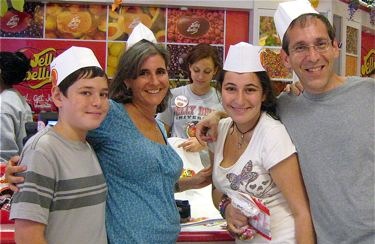 It was the hiccups that scared me the most.
It was the hiccups that scared me the most.
When my father was going through chemotherapy for lymphoma 9 years ago, he developed a terrible case of violent, virulent hiccups that persisted for days. In the story I told myself, it was the hiccups that ultimately killed him, making him too weak to battle both the cancer and the chemo.
So when I came home after my first chemotherapy treatment and started to hiccup, I immediately panicked. It wasn’t that I was afraid I would die – my lymphoma is a different, less aggressive kind. But would I hiccup for days, too? Would I bust or bruise my diaphragm through the relentless assault?
I called my doctor. She knew what the problem was immediately and prescribed a pill which paused the spasms and put my mind at ease. But it was the first sign that my treatment would be filled with surprises – not unlike my diagnosis just six weeks earlier for the cancer itself.
I’ve long harbored a grim curiosity about chemotherapy. While I hoped I’d never have to find out personally, I wondered: what’s it like to sit in an oncology or hematology daycare room with an IV in the arm? Does it hurt? Do you feel like vomiting the whole time? What happens when you get home?
I can’t speak for every patient’s chemo experience – there are so many different types of cancers and treatments and everyone responds differently – but I can tell you about mine.
Let’s start with the hospital. It’s actually kind of boring.
After needle finds vein, you pretty much sit around and wait while many milliliters of fluids in a procession of plastic bags hooked on a tall metal pole slowly make their way into your blood. There’s no feeling of pressure – the meds aren’t being propelled into your body by a pump. Indeed, the only time I really knew anything was happening was the shiver of cold that would hit me whenever the nurse changed the bag to blend up the perfect cocktail of cure.
Of course, it all starts with that prick. To paraphrase Harrison Ford as Indiana Jones, “Needles, why did it have to be needles!â€
Even in normal circumstances, I’ve always hated getting my blood taken. While getting an IV inserted is not substantially different (it just stays in longer than for a blood test), I calculated I will need a whopping 21 IVs before my treatment is over.
Before you even get started, the nurse takes some blood. If your count is off, then it’s no soup for you today.
My particular treatment is nicknamed G-CVP. Each “letter†gets its own bag, plus there are a variety of “pre-meds†administered before the main course, mostly to prevent allergic reactions. Some of them make me drowsy. But I wake up when nature calls.
And it does – plenty during my usual 6-8 hour stay.
With all those fluids flowing into my arm, I need to pee a lot. No problem: there’s a bathroom nearby. But for my particular treatment, I also have an electric-powered box that regulates how fast the immunotherapy meds can drip.
The problem is, to walk to the toilet with my IV pole in tow, I need to disconnect the box from the power. But the electricity strip is located high above the bed. I can’t reach it comfortably with my IV arm.
One rule I learned quickly about getting chemo is: never come to the hospital alone. The accompanying person can quickly grab a doctor or nurse if there’s an issue or – most important – unplug you so you can go to the loo. If I had to wait for the nurse to disconnect me each time, I’d burst.
Other times, you need help maneuvering around all the activity going on in the room. One thing’s for sure: getting chemo in an Israeli hospital is rarely a solitary activity.
There’s the morning snack cart volunteer who brings the sandwich rolls with the super sweet strawberry jam, the chocolate Carlo puddings and a variety of drinks (“I’ve got tea and Pepsi, who wants?â€); the afternoon lunch lady with the endless supply of potato chips and rubbery chicken schnitzel that makes a serving in El Al coach seem like a Michelin-starred meal; the Aldo gourmet ice cream truck (“I’ll take pistachio, pleaseâ€); and the medical musician from the Haverut organization who is happy to strum a soothing song straight out of Psalms.
My wife Jody and I have developed a novel way of passing the time separately yet together. We call it our “in-flight movie trick.†When we fly on an aircraft with individual entertainment screens, we’ll pick out a movie we both want to watch, then press play at the same time.
We have two iPads at home, so for the hospital, I cue up the same TV shows. We tap play and go – no need to crane our necks towards a single shared screen.
When the last bag has drained, the nurse removes the IV with a gentle tug and we’re free to go. There’s no formal discharge, no waiting for papers to be signed – we all know the process will simply start over again soon.
As “uneventful†as the actual daycare experience has been for me, all those chemicals still wipe me out. Nor is that the end of the story. Once I get home, there will be a variety of side effects, both physical and emotional.
But I’ll have to save that for another column.
I first tried to demystify chemotherapy at The Jerusalem Post.

